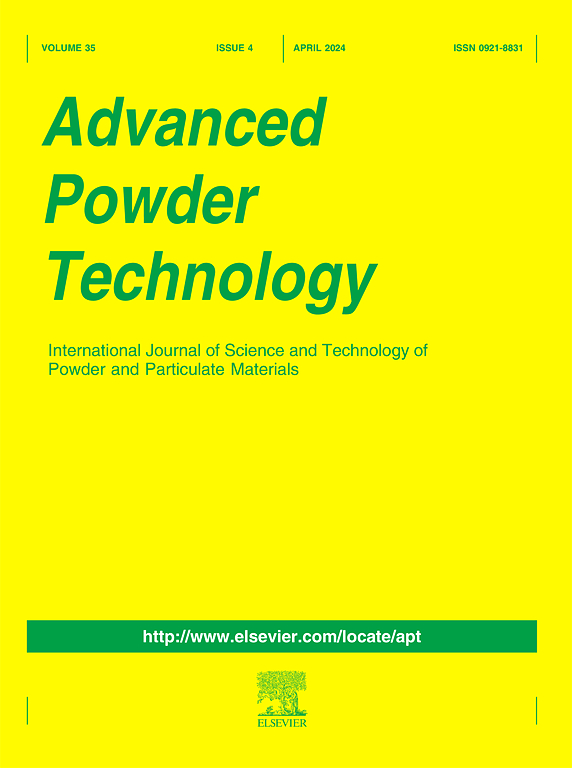Experimental and numerical investigation of liquid–solid contact electrification in a rolling oil tank
IF 4.2
2区 工程技术
Q2 ENGINEERING, CHEMICAL
引用次数: 0
Abstract
Factors influencing electrostatic generation in an oil tank are studied under rolling tank conditions including tank geometry, rolling angle and oil storage, which has little been studied and its working mechanism has never been discovered. This work aims to elucidate the mechanisms of electrostatic generation and accumulation in an oil tank and provide insights to mitigate electrostatic risks during oil transportation. Experiments were conducted using scaled-down stainless-steel oil tanks (light-weight, medium-weight, and heavy-weight) under several rolling conditions proposed. Electrostatic potentials were measured by a high-precision setup comprising a copper sphere and an electrometer. Numerical simulations were carried out to look into the free surface of oil movement and characterize turbulent behavior. It is found that the tank geometry significantly does affect electrostatic generation and accumulation, where the light-weight oil tank exhibits the highest electrostatic potential (103 V) and the medium-weight oil tank exhibits the lowest level (31 V). Increasing rolling angles (10°–30°) increase fluid movement as well as enhance electrostatic potential. Oil storage is found to play a critical role as that the lower level (10.5 %–21 %) leads to a higher electrostatic potential due to more oil-wall interacting. In addition, the friction-induced and contact-separation electrification is found to dominate the electrostatic generation. The medium-weight oil tank reduces sloshing dynamics obviously that can greatly minimize electrostatic risks. Both controlling the rolling angle and optimizing the oil storage are confirmed to mitigate hazards. In the end, this work increases safety theory to design oil tanks and increase the operation standard.

滚动油箱液固接触通电的实验与数值研究
本文研究了油罐几何形状、翻滚角度和储油量等因素对油罐静电产生的影响,但目前对静电产生的影响研究较少,其作用机理也尚未发现。本研究旨在阐明油罐静电产生和积聚的机理,为降低油品运输过程中的静电风险提供依据。实验使用按比例缩小的不锈钢油箱(轻型、中型和重型)在几种轧制条件下进行。静电电位的测量是由一个铜球和静电计组成的高精度装置。通过数值模拟研究了油液的自由表面运动和湍流特性。研究发现,油罐的几何形状对静电的产生和积累有显著影响,其中轻质油罐静电电位最高(103 V),中等重量油罐静电电位最低(31 V)。增加滚动角度(10°-30°)增加流体运动并增强静电势。研究发现,储油量起着至关重要的作用,因为较低的储油量(10.5% - 21%)由于更多的油壁相互作用而导致较高的静电势。此外,摩擦致电和接触分离致电是静电产生的主要原因。中等重量的油罐明显减小了晃动动力学,大大降低了静电风险。通过对滚动角度的控制和储油量的优化,可以有效地降低风险。最后,为油罐的设计增加了安全理论依据,提高了操作标准。
本文章由计算机程序翻译,如有差异,请以英文原文为准。
求助全文
约1分钟内获得全文
求助全文
来源期刊

Advanced Powder Technology
工程技术-工程:化工
CiteScore
9.50
自引率
7.70%
发文量
424
审稿时长
55 days
期刊介绍:
The aim of Advanced Powder Technology is to meet the demand for an international journal that integrates all aspects of science and technology research on powder and particulate materials. The journal fulfills this purpose by publishing original research papers, rapid communications, reviews, and translated articles by prominent researchers worldwide.
The editorial work of Advanced Powder Technology, which was founded as the International Journal of the Society of Powder Technology, Japan, is now shared by distinguished board members, who operate in a unique framework designed to respond to the increasing global demand for articles on not only powder and particles, but also on various materials produced from them.
Advanced Powder Technology covers various areas, but a discussion of powder and particles is required in articles. Topics include: Production of powder and particulate materials in gases and liquids(nanoparticles, fine ceramics, pharmaceuticals, novel functional materials, etc.); Aerosol and colloidal processing; Powder and particle characterization; Dynamics and phenomena; Calculation and simulation (CFD, DEM, Monte Carlo method, population balance, etc.); Measurement and control of powder processes; Particle modification; Comminution; Powder handling and operations (storage, transport, granulation, separation, fluidization, etc.)
 求助内容:
求助内容: 应助结果提醒方式:
应助结果提醒方式:


